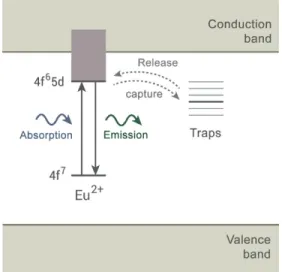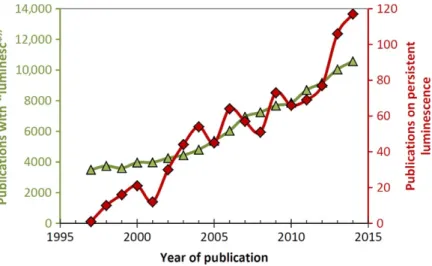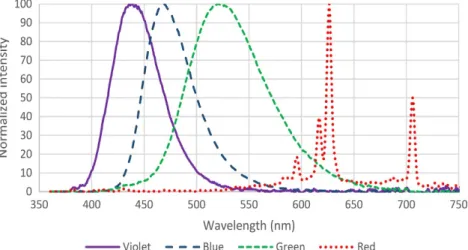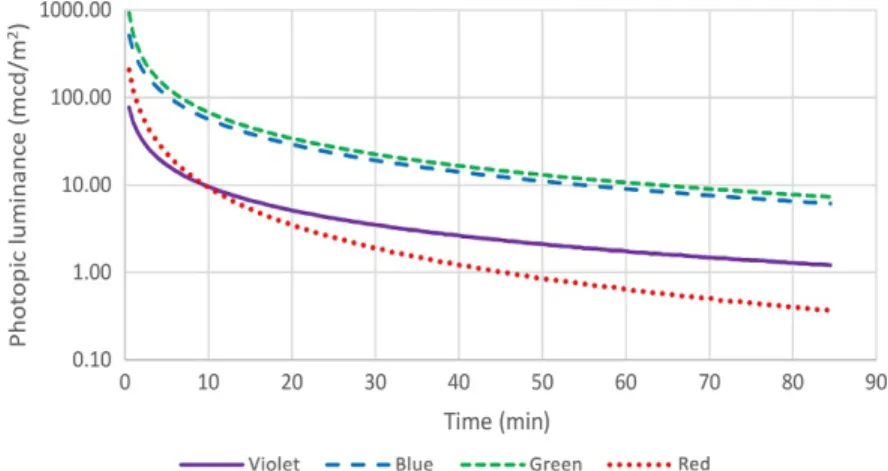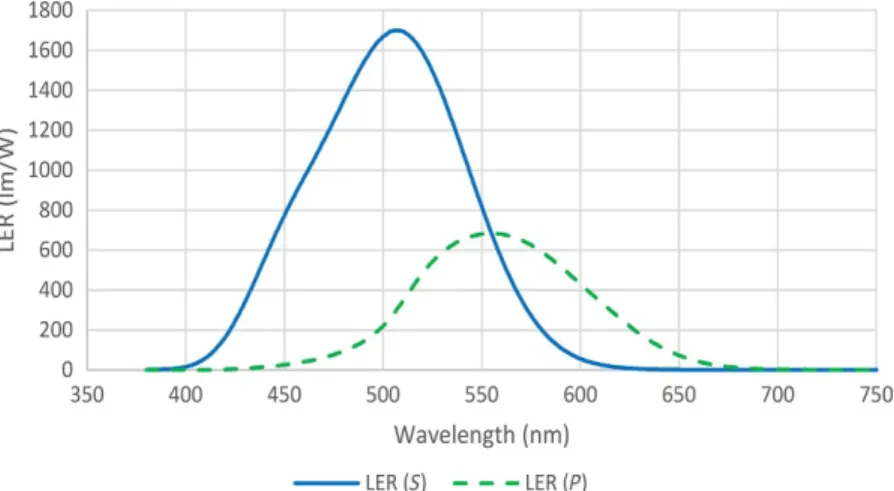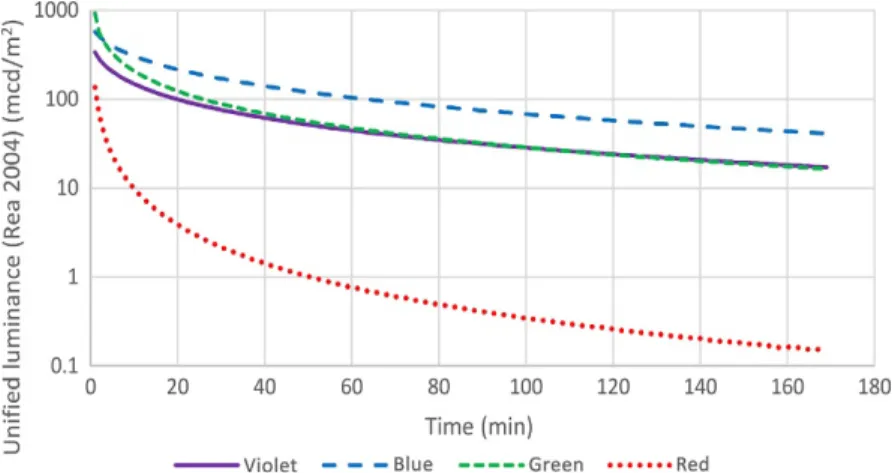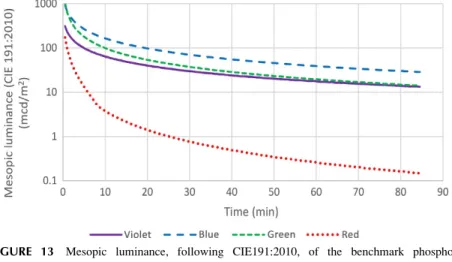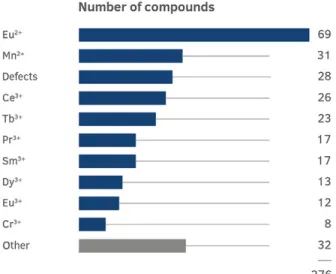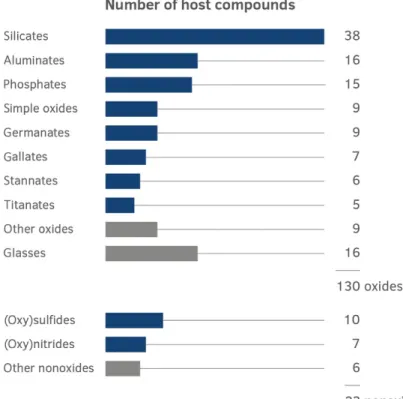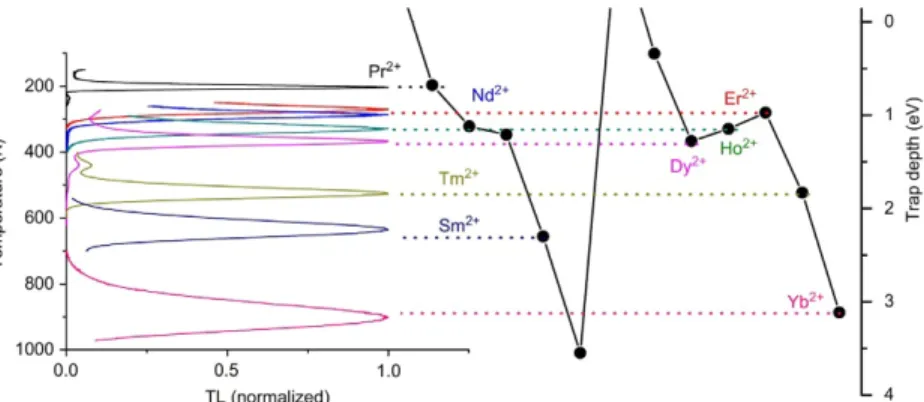Chemistry of Rare Earths Volume 48
Including Actinides
OF RARE EARTHS Advisory Editorial Board
GIN-YA ADACHI Kobe, Japan WILLIAM J. EVANS
Irvine, USA YURI GRIN Dresden, Germany SUZAN M. KAUZLARICH
Davis, USA MICHAEL F. REID Canterbury, New Zealand
CHUNHUA YAN Beijing, P.R. China
Editors Emeritus KARL A. GSCHNEIDNER, JR
Ames, USA LEROY EYRINGw
Tempe, USA
wDeceased (2005)
Handbook on the
Physics and Chemistry of Rare Earths
Volume 48
Including Actinides
Editors
Jean-Claude Bu¨nzli
Swiss Federal Institute of Technology, Lausanne (EPFL) Institute of Chemical Sciences and Engineering BCH 1402
CH-1015 Lausanne Switzerland
Vitalij K. Pecharsky
The Ames Laboratory, U.S. Department of Energy, and Department of Materials Science and Engineering Iowa State University,
Ames, Iowa 50011-3020 USA
North-Holland is an imprint of Elsevier
Radarweg 29, PO Box 211, 1000 AE Amsterdam, The Netherlands The Boulevard, Langford Lane, Kidlington, Oxford OX5 1GB, UK Copyright©2015 Elsevier B.V. All rights reserved
No part of this publication may be reproduced or transmitted in any form or by any means, electronic or mechanical, including photocopying, recording, or any information storage and retrieval system, without permission in writing from the publisher. Details on how to seek permission, further information about the Publisher’s permissions policies and our arrangements with organizations such as the Copyright Clearance Center and the Copyright Licensing Agency, can be found at our website:
www.elsevier.com/permissions.
This book and the individual contributions contained in it are protected under copyright by the Publisher (other than as may be noted herein).
Notices
Knowledge and best practice in this field are constantly changing. As new research and experience broaden our understanding, changes in research methods, professional practices, or medical treatment may become necessary.
Practitioners and researchers must always rely on their own experience and knowledge in evaluating and using any information, methods, compounds, or experiments described herein. In using such information or methods they should be mindful of their own safety and the safety of others, including parties for whom they have a
professional responsibility.
To the fullest extent of the law, neither the Publisher nor the authors, contributors, or editors, assume any liability for any injury and/or damage to persons or property as a matter of products liability, negligence or otherwise, or from any use or operation of any methods, products, instructions, or ideas contained in the material herein.
ISBN: 978-0-444-63483-2 ISSN: 0168-1273
For information on all North-Holland publications visit our website athttp://store.elsevier.com/
Contributors vii
Preface ix
Contents of Volumes 1–47 xv
Index of Contents of Volumes 1–48 xxix
274. Persistent Phosphors 1
Philippe F. Smet, Koen Van den Eeckhout, Olivier Q. De Clercq, and Dirk Poelman
275. Quaternary R2X3dPbXdZX2
(X5S, Se; Z5Si, Ge, Sn) Chalcogenides 109
Lubomir D. Gulay, Marek Daszkiewicz, and Oleg V. Marchuk
276. Hybrid Materials of the f-Elements Part II:
The Uranyl Cation 163
Robert G. Surbella III and Christopher L. Cahill
277. Progress in the Separation Processes for
Rare Earth Resources 287
Zhifeng Zhang, Qiong Jia, and Wuping Liao
Index 377
v
Contributors
Numbers in Parentheses indicate the pages on which the author’s contributions begin.
Christopher L. Cahill (163), Department of Chemistry, The George Washington University, Washington, District of Columbia, USA
Marek Daszkiewicz (109), Institute of Low Temperature and Structure Research, Polish Academy of Sciences, Wrocław, Poland
Olivier Q. De Clercq (1), LumiLab, Department of Solid State Sciences, Ghent University, Ghent, Belgium
Lubomir D. Gulay (109), Department of Ecology and Protection of Environment, Eastern European National University, Lutsk, Ukraine
Qiong Jia (287), College of Chemistry, Jilin University, Changchun, China
Wuping Liao (287), State Key Laboratory of Rare Earth Resource Utilization, ERC for the Separation and Purification of REs and Thorium, Changchun Institute of Applied Chemistry, Chinese Academy of Sciences, Changchun, China
Oleg V. Marchuk (109), Department of Inorganic and Physical Chemistry, Eastern European National University, Lutsk, Ukraine
Dirk Poelman (1), LumiLab, Department of Solid State Sciences, Ghent University, Ghent, Belgium
Philippe F. Smet (1), LumiLab, Department of Solid State Sciences, Ghent University, Ghent, Belgium
Robert G. Surbella III (163), Department of Chemistry, The George Washington University, Washington, District of Columbia, USA
Koen Van den Eeckhout (1), LumiLab, Department of Solid State Sciences, Ghent University, Ghent, Belgium
Zhifeng Zhang (287), State Key Laboratory of Rare Earth Resource Utilization, ERC for the Separation and Purification of REs and Thorium, Changchun Institute of Applied Chemistry, Chinese Academy of Sciences, Changchun, China
vii
Preface
These elements perplex us in our reaches [sic], baffle us in our speculations, and haunt us in our very dreams. They stretch like an unknown sea before us—mocking, mystifying, and murmuring strange revelations and possibilities.
Sir William Crookes (February 16, 1887) Volume 48 of the Handbook on the Physics and Chemistry of Rare Earths adds four chapters to the series, covering broadly different, but timely, sub- jects ranging from luminescent materials to properties of chalcogenides, ura- nyl hybrid materials, and separation processes. Featured themes include persistent luminescence, a phenomenon used in emerging applications such as signage and bioimaging, the phase diagrams, structure, and physical prop- erties of quaternary rare earth/lead/group IV (Si, Ge, Sn)/sulfur or selenium compounds, structural chemistry of crystalline uranyl-containing compounds obtained via hydrothermal synthesis, as well as description of state-of-the- art in separation and purification processes of rare earths along with the prep- aration of high-purity rare-earth and thorium metals.
The first chapter (Chapter 274) is devoted to persistent luminescence, a phenomenon whereby a compound keeps emitting light for a long time after excitation is switched off. Ancient civilizations knew about this curious phenomenon, but the first account of it in the Western world dates back to the seventeenth century when the Bologna stone, obtained by calcining barite, was described. The emission of light in such materials depends on traps gener- ated by tiny amounts of impurities; hence, different synthetic conditions lead to widely different emission colors. Studying this fascinating phenomenon is diffi- cult so that it remained a curiosity until the twentieth century when zinc sulfide doped with transition metals (cobalt, copper) started to play an important role in luminous paints. Contributions of lanthanides to the field started at the end of the 1960s when strontium aluminate doped with divalent europium was discov- ered. A further and decisive impetus occurred in the mid-1990s initiated by the finding that co-doping trivalent dysprosium in this material produced a much brighter persistent phosphor. The chapter reviews all aspects of lanthanide per- sistent luminescence along with a critical evaluation of potential applications in marking, solar energy conversion, and biosciences.
Quaternary rare-earth chalcogenide systems R2X3dPbXdZX2 (X¼S, Se; Z¼Si, Ge, Sn) are the subject of Chapter 275. These compounds are of broad interest in both basic and applied sciences due to their intriguing
ix
thermal, optical, electrical, and magnetic properties. The design of increas- ingly complex chalcogenide compounds is indeed vital for modern materials science, primarily in reference to the development of nonlinear optical devices. The systems based on lead, sulfur, and selenium are of special impor- tance because substitution of lead with rare earths results in modified optical and magnetic properties that can be modulated while preserving the parent crystal structure. These new phases can also be obtained at the nanoscale, which considerably broadens their potential applications, for instance in catal- ysis, biotechnology, or medicine. In this review, synthetic conditions are detailed, followed by a systematic presentation of known phase diagrams, structures, and magnetic properties.
Chapter 276 deals with crystalline hybrid materials of uranyl. These materi- als combine a substrate (organic or inorganic) with uranyl ion or its complexes that are blended on the molecular scale. Generally speaking, hybrid materials are found in numerous systems and can be broadly divided into sol–gel (glasses, silica, organically modified xerogels), porous (metal-organic frameworks), mesoporous (silicates, zeolites), polymeric, intercalation (layered double hydro- xides), and nanocomposite (nanoparticles) materials. Uranyl hydrolysis and complex aqueous speciation are the red thread of the review as they represent drivers for structural diversity. The chapter explores covalent bonding with O- and N-donor ligands before highlighting ways of programming targeted coordination geometries, compositions, and connectivities into the hybrid mate- rials. Purely supramolecular systems, assembled thanks to noncovalent bonds from simple tectons under high concentrations of anions such as chloride, bro- mide, or isothiocyanate, are also presented. Finally, luminescence properties are described, particularly with respect to structure/property relationships.
The final chapter (Chapter 277) presents a historical insight as well as recent progresses in separation processes of rare earths, with a special focus on Chinese operations. Rare earth ores always contain a blend of several elements, and if some applications rely on mixtures (e.g., the Mischmetal, neodymium/praseodymium/dysprosium mixtures for magnets, or lanthanum/
cerium mixtures for nickel metal hydride batteries or catalysts), many high-technology uses need high-purity individual elements. Separation and purification operations are complex, time consuming, and have negative environmental effects. This points to the importance of developing efficient separation taking into account environmental issues, by making use of
“greener” reactants and/or by recycling the chemicals involved. Both funda- mental and applied investigations have to be combined to reach this goal.
The chapter reviews the various extractants, methods, and equipment that have been developed for achieving efficient methodologies, progresses being sustained by adequate theoretical modeling. It ends by describing technologies for the production of very high-purity rare-earth elements and thorium, a by-product of rare-earth extraction.
CHAPTER 274: PERSISTENT PHOSPHORS
Philippe F. Smet, Koen Van den Eeckout, Olivier Q. De Clercq, and Dirk Poelman
LumiLab, Department of Solid State Sciences, Ghent University, Ghent, Belgium. E-mail: [email protected]
Outlook
Mechano- luminescence
Thermoluminescence
Materials overview
Visibility Characterization
release capture
traps emission
absorption
Synthesis
In vivo imaging
Persistent luminescence is the phenomenon whereby a material keeps emitting light for seconds to hours after the excitation has stopped. This chap- ter describes the history of this class of materials and how the discovery of a new family of very efficient persistent phosphors has given a boost to the development of both new materials and applications. Synthesis conditions and analytical techniques specific to persistent luminescent compounds are described, together with ways to evaluate their performance in terms of human eye perception. A state of the art is presented about the materials—
hosts and dopants—currently investigated for persistent luminescence, consis- tently referring to the original literature. Finally,in vivo medical imaging is shown to be a promising but challenging application of long-wavelength per- sistent luminescence and the relation between persistent luminescence and mechanoluminescence are described.
CHAPTER 275: QUATERNARY R2X3dPbXdZX2
(X5S, Se; Z5Si, Ge, Sn) CHALCOGENIDES
Lubomir D. Gulay*, Marek Daszkiewicz†, and Oleg V. Marchuk**
*Department of Ecology and Protection of Environment, Eastern European University, Lutsk, Ukraine
†Institute of Low-Temperature and Structure Research, Polish Academy of Sciences, Wroclaw, Poland. E-mail: [email protected]
**Department of Inorganic and Physical Chemistry, Eastern European National University, Lutsk, Ukraine
Complex ternary, quaternary, and multicomponent chalcogenides contain- ing rare earths are interesting because of potential applications in the fields of ionic conductivity and nonlinear optics. The current knowledge about experi- mental investigations of phase diagrams, crystallographic relationships, and magnetic properties of quaternary rare-earth chalcogenides R2X3dPbXdZX2 (X¼S, Se; Z¼Si, Ge, Sn) is the focus of the chapter. The initial section describes typical preparation of these novel materials in small quantities for studies of their basic physical properties and serves as a guide for those inter- ested in preparing larger quantities in order to explore their potential for prac- tical applications. Then the structure types of ternary PbdZdX (X¼S, Se;
Z¼Si, Ge, Sn) systems are presented, before the review concentrates on the rare-earth-containing quaternary chalcogenides that are discussed according to their structure type. Description of superstructures and known magnetic properties concludes the chapter.
CHAPTER 276: HYBRID MATERIALS OF THE f-ELEMENTS PART II: THE URANYL CATION
Robert G. Surbella III and Christopher L. Cahill
The George Washington University, Washington, DC, USA. E-mail:
The catalog of uranyl-bearing hybrid materials has expanded considerably over the past 10–15 years. Researchers have drawn inspiration from the rich portfolio of structural topologies found in naturally occurring uranyl mineral phases where uranyl oligomerization stemming from hydrolysis is the norm.
With these phenomena as guiding principles, our group in particular has pur- sued a program of exploring the relationship between synthetic reaction con- ditions, including ligand geometries and functionalities, with solid-state structure. As the synthetic efforts have flourished, a wide variety of structure types have emerged, yet the ability to fully correlate reaction conditions with resulting topologies remains elusive. As such, this chapter provides an over- view of (whenever possible) synthetic “causes and effects” in the hydrother- mal synthesis of uranyl hybrid materials. It then progresses to more recent developments wherein milder, high anion conditions are utilized to develop themes of assembly via noncovalent interactions between a more restricted suite of uranyl species.
CHAPTER 277: PROGRESS IN THE SEPARATION PROCESSES FOR RARE EARTH RESOURCES
Zhifeng Zhang1, Qiong Jia2, Wuping Liao1,*
1State Key Laboratory of Rare Earth Resource Utilization, Changchun Institute of Applied Chemistry, Chinese Academy of Sciences, Changchun.
E-mail: [email protected]
2College of Chemistry, Jilin University, Changchun, China
Novel extractants Extraction equipment Theoretical modeling
Solvent extraction
Separation processes RE mines
Ion exchange
Double salt precipitation
High-purity REs RE oxides
Rare earth elements have widespread applications in materials critical for many high-technology applications, including catalysts, permanent magnets, phosphors, lasers, and rechargeable batteries. Individual rare-earth elements are often needed so that separation and purification of rare-earth concentrates are crucial. Importantly, these operations are suffering from environmental problems and viable utilization of the resources. The chapter gives an over- view of the evolution in fundamental research and industrial separation pro- cesses for rare earths. First, the progresses in extractants, novel equipment, alternative technologies, and theoretical modeling are summarized. Industrial hydrometallurgy processes are discussed and evaluated with respect to differ- ent ores of various origins. The preparation of highly pure rare earths and associated elements such as thorium is then presented. Easily accessible resources and environmentally friendly processes are essential issues to deal with in order to ensure sustainable developments in rare earth metallurgy.
Jean-Claude G. Bu¨nzli Vitalij K. Pecharsky
VOLUME 1: Metals
1978, 1st repr. 1982, 2nd repr. 1991; ISBN 0-444-85020-1 1. Z.B. Goldschmidt,Atomic properties (free atom) 1
2. B.J. Beaudry and K.A. Gschneidner Jr,Preparation and basic properties of the rare earth metals 173
3. S.H. Liu,Electronic structure of rare earth metals 233 4. D.C. Koskenmaki and K.A. Gschneidner Jr,Cerium 337
5. L.J. Sundstr€om,Low temperature heat capacity of the rare earth metals 379 6. K.A. McEwen,Magnetic and transport properties of the rare earths 411 7. S.K. Sinha,Magnetic structures and inelastic neutron scattering: metals, alloys and
compounds 489
8. T.E. Scott,Elastic and mechanical properties 591
9. A. Jayaraman,High pressure studies: metals, alloys and compounds 707 10. C. Probst and J. Wittig,Superconductivity: metals, alloys and compounds 749 11. M.B. Maple, L.E. DeLong and B.C. Sales,Kondo effect: alloys and compounds 797 12. M.P. Dariel,Diffusion in rare earth metals 847
Subject index 877
VOLUME 2: Alloys and intermetallics
1979, 1st repr. 1982, 2nd repr. 1991; ISBN 0-444-85021-X
13. A. landelli and A. Palenzona,Crystal chemistry of intermetallic compounds 1 14. H.R. Kirchmayr and C.A. Poldy,Magnetic properties of intermetallic compounds of
rare earth metals 55
15. A.E. Clark,Magnetostrictive RFe2intermetallic compounds 231 16. J.J. Rhyne,Amorphous magnetic rare earth alloys 259 17. P. Fulde,Crystal fields 295
18. R.G. Barnes,NMR, EPR and M€ossbauer effect: metals, alloys and compounds 387 19. P. Wachter,Europium chalcogenides: EuO, EuS, EuSe and EuTe 507
20. A. Jayaraman,Valence changes in compounds 575 Subject index 613
VOLUME 3: Non-metallic compounds–I 1979, 1st repr. 1984; ISBN 0-444-85215-8
21. L.A. Haskin and T.P. Paster,Geochemistry and mineralogy of the rare earths 1 22. J.E. Powell,Separation chemistry 81
23. C.K. Jørgensen,Theoretical chemistry of rare earths 111
24. W.T. Carnall,The absorption and fluorescence spectra of rare earth ions in solution 171
25. L.C. Thompson,Complexes 209
26. G.G. Libowitz and A.J. Maeland,Hydrides 299 27. L. Eyring,The binary rare earth oxides 337
28. D.J.M. Bevan and E. Summerville,Mixed rare earth oxides 401
xv
29. C.P. Khattak and F.F.Y. Wang,Perovskites and garnets 525
30. L.H. Brixner, J.R. Barkley and W. Jeitschko,Rare earth molybdates (VI) 609 Subject index 655
VOLUME 4: Non-metallic compounds–II 1979, 1st repr. 1984; ISBN 0-444-85216-6 31. J. Flahaut,Sulfides, selenides and tellurides 1 32. J.M. Haschke,Halides 89
33. F. Hulliger,Rare earth pnictides 153
34. G. Blasse,Chemistry and physics of R-activated phosphors 237 35. M.J. Weber,Rare earth lasers 275
36. F.K. Fong,Nonradiative processes of rare-earth ions in crystals 317
37A. J.W. O’Laughlin,Chemical spectrophotometric and polarographic methods 341 37B. S.R. Taylor,Trace element analysis of rare earth elements by spark source mass
spectroscopy 359
37C. R.J. Conzemius,Analysis of rare earth matrices by spark source mass spectrometry 377
37D. E.L. DeKalb and V.A. Fassel,Optical atomic emission and absorption methods 405 37E. A.P. D’Silva and V.A. Fassel,X-ray excited optical luminescence of the rare
earths 441
37F. F.W.V. Boynton,Neutron activation analysis 457
37G. S. Schuhmann and J.A. Philpotts,Mass-spectrometric stable-isotope dilution analysis for lanthanides in geochemical materials 471
38. J. Reuben and G.A. Elgavish,Shift reagents and NMR of paramagnetic lanthanide complexes 483
39. J. Reuben,Bioinorganic chemistry: lanthanides as probes in systems of biological interest 515
40. T.J. Haley,Toxicity 553 Subject index 587
VOLUME 5
1982, 1st repr. 1984; ISBN 0-444-86375-3
41. M. Gasgnier,Rare earth alloys and compounds as thin films 1 42. E. Gratz and M.J. Zuckermann,Transport properties (electrical resitivity,
thermoelectric power thermal conductivity) of rare earth intermetallic compounds 117
43. F.P. Netzer and E. Bertel,Adsorption and catalysis on rare earth surfaces 217 44. C. Boulesteix,Defects and phase transformation near room temperature in rare earth
sesquioxides 321
45. O. Greis and J.M. Haschke,Rare earth fluorides 387
46. C.A. Morrison and R.P. Leavitt,Spectroscopic properties of triply ionized lanthanides in transparent host crystals 461
Subject index 693
VOLUME 6
1984; ISBN 0-444-86592-6
47. K.H.J. Buschow,Hydrogen absorption in intermetallic compounds 1
48. E. Parthe´ and B. Chabot,Crystal structures and crystal chemistry of ternary rare earth–transition metal borides, silicides and homologues 113
49. P. Rogl,Phase equilibria in ternary and higher order systems with rare earth elements and boron 335
50. H.B. Kagan and J.L. Namy,Preparation of divalent ytterbium and samarium derivatives and their use in organic chemistry 525
Subject index 567
VOLUME 7
1984; ISBN 0-444-86851-8
51. P. Rogl,Phase equilibria in ternary and higher order systems with rare earth elements and silicon 1
52. K.H.J. Buschow,Amorphous alloys 265
53. H. Schumann and W. Genthe,Organometallic compounds of the rare earths 446 Subject index 573
VOLUME 8
1986; ISBN 0-444-86971-9
54. K.A. Gschneidner Jr and F.W. Calderwood,Intra rare earth binary alloys: phase relationships, lattice parameters and systematics 1
55. X. Gao,Polarographic analysis of the rare earths 163
56. M. Leskela¨ and L. Niinist€o,Inorganic complex compounds I 203 57. J.R. Long,Implications in organic synthesis 335
Errata 375 Subject index 379
VOLUME 9
1987; ISBN 0-444-87045-8
58. R. Reisfeld and C.K. Jørgensen,Excited state phenomena in vitreous materials 1 59. L. Niinist€o and M. Leskela¨,Inorganic complex compounds II 91
60. J.-C.G. Bu¨nzli,Complexes with synthetic ionophores 321
61. Zhiquan Shen and Jun Ouyang,Rare earth coordination catalysis in stereospecific polymerization 395
Errata 429 Subject index 431
VOLUME 10: High energy spectroscopy 1987; ISBN 0-444-87063-6
62. Y. Baer and W.-D. Schneider,High-energy spectroscopy of lanthanide materials–An overview 1
63. M. Campagna and F.U. Hillebrecht,f-electron hybridization and dynamical screening of core holes in intermetallic compounds 75
64. O. Gunnarsson and K. Sch€onhammer,Many-body formulation of spectra of mixed valence systems 103
65. A.J. Freeman, B.I. Min and M.R. Norman,Local density supercell theory of photoemission and inverse photoemission spectra 165
66. D.W. Lynch and J.H. Weaver,Photoemission of Ce and its compounds 231 67. S. Hu¨fner,Photoemission in chalcogenides 301
68. J.F. Herbst and J.W. Wilkins,Calculation of 4f excitation energies in the metals and relevance to mixed valence systems 321
69. B. Johansson and N. Ma˚rtensson,Thermodynamic aspects of 4f levels in metals and compounds 361
70. F.U. Hillebrecht and M. Campagna,Bremsstrahlung isochromat spectroscopy of alloys and mixed valent compounds 425
71. J. R€ohler,X-ray absorption and emission spectra 453
72. F.P. Netzer and J.A.D. Matthew,Inelastic electron scattering measurements 547 Subject index 601
VOLUME 11: Two-hundred-year impact of rare earths on science 1988; ISBN 0-444-87080-6
H.J. Svec,Prologue 1
73. F. Szabadva´ry,The history of the discovery and separation of the rare earths 33 74. B.R. Judd,Atomic theory and optical spectroscopy 81
75. C.K. Jørgensen,Influence of rare earths on chemical understanding and classification 197
76. J.J. Rhyne,Highlights from the exotic phenomena of lanthanide magnetism 293 77. B. Bleaney,Magnetic resonance spectroscopy and hyperfine interactions 323 78. K.A. Gschneidner Jr and A.H. Daane,Physical metallurgy 409
79. S.R. Taylor and S.M. McLennan,The significance of the rare earths in geochemistry and cosmochemistry 485
Errata 579 Subject index 581
VOLUME 12
1989; ISBN 0-444-87105-5
80. J.S. Abell,Preparation and crystal growth of rare earth elements and intermetallic compounds 1
81. Z. Fisk and J.P. Remeika,Growth of single crystals from molten metal fluxes 53 82. E. Burzo and H.R. Kirchmayr,Physical properties of R2Fe14B-based alloys 71 83. A. Szytuła and J. Leciejewicz,Magnetic properties of ternary intermetallic compounds
of the RT2X2type 133
84. H. Maletta and W. Zinn,Spin glasses 213 85. J. van Zytveld,Liquid metals and alloys 357
86. M.S. Chandrasekharaiah and K.A. Gingerich,Thermodynamic properties of gaseous species 409
87. W.M. Yen,Laser spectroscopy 433 Subject index 479
VOLUME 13
1990; ISBN 0-444-88547-1
88. E.I. Gladyshevsky, O.I. Bodak and V.K. Pecharsky,Phase equilibria and crystal chemistry in ternary rare earth systems with metallic elements 1
89. A.A. Eliseev and G.M. Kuzmichyeva,Phase equilibrium and crystal chemistry in ternary rare earth systems with chalcogenide elements 191
90. N. Kimizuka, E. Takayama-Muromachi and K. Siratori,The systems R2O3–M2O3– M0O 283
91. R.S. Houk,Elemental analysis by atomic emission and mass spectrometry with inductively coupled plasmas 385
92. P.H. Brown, A.H. Rathjen, R.D. Graham and D.E. Tribe,Rare earth elements in biological systems 423
Errata 453 Subject index 455
VOLUME 14
1991; ISBN 0-444-88743-1
93. R. Osborn, S.W. Lovesey, A.D. Taylor and E. Balcar,Intermultiplet transitions using neutron spectroscopy 1
94. E. Dormann,NMR in intermetallic compounds 63
95. E. Zirngiebl and G. Gu¨ntherodt,Light scattering in intermetallic compounds 163 96. P. Thalmeier and B. Lu¨thi,The electron–phonon interaction in intermetallic
compounds 225
97. N. Grewe and F. Steglich,Heavy fermions 343 Subject index 475
VOLUME 15
1991; ISBN 0-444-88966-3
98. J.G. Sereni,Low-temperature behaviour of cerium compounds 1 99. G.-Y. Adachi, N. Imanaka and Zhang Fuzhong,Rare earth carbides 61 100. A. Simon, Hj. Mattausch, G.J. Miller, W. Bauhofer and R.K. Kremer,Metal-rich
halides 191
101. R.M. Almeida,Fluoride glasses 287
102. K.L. Nash and J.C. Sullivan,Kinetics of complexation and redox reactions of the lanthanides in aqueous solutions 347
103. E.N. Rizkalla and G.R. Choppin,Hydration and hydrolysis of lanthanides 393 104. L.M. Vallarino,Macrocycle complexes of the lanthanide(III), yttrium(III), and
dioxouranium (VI) ions from metal-templated syntheses 443 Errata 513
Subject index 515
CUMULATIVE INDEX, Vols. 1–15 1993; ISBN 0-444-89965-0
VOLUME 16
1993; ISBN 0-444-89782-8
105. M. Loewenhaupt and K.H. Fischer,Valence-fluctuation and heavy-fermion 4f systems 1
106. I.A. Smirnov and V.S. Oskotski,Thermal conductivity of rare earth compounds 107 107. M.A. Subramanian and A.W. Sleight,Rare earth pyrochlores 225
108. R. Miyawaki and I. Nakai,Crystal structures of rare earth minerals 249 109. D.R. Chopra,Appearance potential spectroscopy of lanthanides and their
intermetallics 519 Author index 547 Subject index 579
VOLUME 17: Lanthanides/Actinides: Physics–I 1993; ISBN 0-444-81502-3
110. M.R. Norman and D.D. Koelling,Electronic structure, Fermi surfaces, and superconductivity in f electron metals 1
111. S.H. Liu,Phenomenological approach to heavy-fermion systems 87 112. B. Johansson and M.S.S. Brooks,Theory of cohesion in rare earths and
actinides 149
113. U. Benedict and W.B. Holzapfel,High-pressure studies–Structural aspects 245
114. O. Vogt and K. Mattenberger,Magnetic measurements on rare earth and actinide monopnictides and monochalcogenides 301
115. J.M. Fournier and E. Gratz,Transport properties of rare earth and actinide intermetallics 409
116. W. Potzel, G.M. Kalvius and J. Gal,M€ossbauer studies on electronic structure of intermetallic compounds 539
117. G.H. Lander,Neutron elastic scattering from actinides and anomalous lanthanides 635
Author index 711 Subject index 753
VOLUME 18: Lanthanides/Actinides: Chemistry 1994; ISBN 0-444-81724-7
118. G.T. Seaborg,Origin of the actinide concept 1
119. K. Balasubramanian,Relativistic effects and electronic structure of lanthanide and actinide molecules 29
120. J.V. Beitz,Similarities and differences in trivalent lanthanide- and actinide-ion solution absorption spectra and luminescence studies 159
121. K.L. Nash,Separation chemistry for lanthanides and trivalent actinides 197 122. L.R. Morss,Comparative thermochemical and oxidation–reduction properties of
lanthanides and actinides 239
123. J.W. Ward and J.M. Haschke,Comparison of 4f and 5f element hydride properties 293
124. H.A. Eick,Lanthanide and actinide halides 365
125. R.G. Haire and L. Eyring,Comparisons of the binary oxides 413
126. S.A. Kinkead, K.D. Abney and T.A. O’Donnell,f-Element speciation in strongly acidic media: lanthanide and mid-actinide metals, oxides, fluorides and oxide fluorides in superacids 507
127. E.N. Rizkalla and G.R. Choppin,Lanthanides and actinides hydration and hydrolysis 529
128. G.R. Choppin and E.N. Rizkalla,Solution chemistry of actinides and lanthanides 559
129. J.R. Duffield, D.M. Taylor and D.R. Williams,The biochemistry of the f-elements 591
Author index 623 Subject index 659
VOLUME 19: Lanthanides/Actinides: Physics–II 1994; ISBN 0-444-82015-9
130. E. Holland-Moritz and G.H. Lander,Neutron inelastic scattering from actinides and anomalous lanthanides 1
131. G. Aeppli and C. Broholm,Magnetic correlations in heavy-fermion systems: neutron scattering from single crystals 123
132. P. Wachter,Intermediate valence and heavy fermions 177
133. J.D. Thompson and J.M. Lawrence,High pressure studies–Physical properties of anomalous Ce, Yb and U compounds 383
134. C. Colinet and A. Pasturel,Thermodynamic properties of metallic systems 479 Author index 649
Subject index 693
VOLUME 20
1995; ISBN 0-444-82014-0
135. Y. O¯ nuki and A. Hasegawa,Fermi surfaces of intermetallic compounds 1 136. M. Gasgnier,The intricate world of rare earth thin films: metals, alloys,
intermetallics, chemical compounds,... 105
137. P. Vajda,Hydrogen in rare-earth metals, including RH2+xphases 207
138. D. Gignoux and D. Schmitt,Magnetic properties of intermetallic compounds 293 Author index 425
Subject index 457
VOLUME 21
1995; ISBN 0-444-82178-3
139. R.G. Bautista,Separation chemistry 1
140. B.W. Hinton,Corrosion prevention and control 29 141. N.E. Ryan,High-temperature corrosion protection 93
142. T. Sakai, M. Matsuoka and C. Iwakura,Rare earth intermetallics for metal–hydrogen batteries 133
143. G.-y. Adachi and N. Imanaka,Chemical sensors 179
144. D. Garcia and M. Faucher,Crystal field in non-metallic (rare earth) compounds 263 145. J.-C.G. Bu¨nzli and A. Milicic-Tang,Solvation and anion interaction in organic
solvents 305
146. V. Bhagavathy, T. Prasada Rao and A.D. Damodaran,Trace determination of lanthanides in high-purity rare-earth oxides 367
Author index 385 Subject index 411
VOLUME 22
1996; ISBN 0-444-82288-7
147. C.P. Flynn and M.B. Salamon,Synthesis and properties of single-crystal nanostructures 1
148. Z.S. Shan and D.J. Sellmyer,Nanoscale rare earth–transition metal multilayers:
magnetic structure and properties 81
149. W. Suski,The ThMn12-type compounds of rare earths and actinides: structure, magnetic and related properties 143
150. L.K. Aminov, B.Z. Malkin and M.A. Teplov,Magnetic properties of nonmetallic lanthanide compounds 295
151. F. Auzel,Coherent emission in rare-earth materials 507
152. M. Dolg and H. Stoll,Electronic structure calculations for molecules containing lanthanide atoms 607
Author index 731 Subject index 777
VOLUME 23
1996; ISBN 0-444-82507-X
153. J.H. Forsberg,NMR studies of paramagnetic lanthanide complexes and shift reagents 1
154. N. Sabbatini, M. Guardigli and I. Manet,Antenna effect in encapsulation complexes of lanthanide ions 69
155. C. G€orller-Walrand and K. Binnemans,Rationalization of crystal-field parameterization 121
156. Yu. Kuz’ma and S. Chykhrij,Phosphides 285
157. S. Boghosian and G.N. Papatheodorou,Halide vapors and vapor complexes 435 158. R.H. Byrne and E.R. Sholkovitz,Marine chemistry and geochemistry of the
lanthanides 497 Author index 595 Subject index 631
VOLUME 24
1997; ISBN 0-444-82607-6
159. P.A. Dowben, D.N. McIlroy and Dongqi Li,Surface magnetism of the lanthanides 1 160. P.G. McCormick,Mechanical alloying and mechanically induced chemical reactions 47 161. A. Inoue,Amorphous, quasicrystalline and nanocrystalline alloys in Al- and Mg-based
systems 83
162. B. Elschner and A. Loidl,Electron-spin resonance on localized magnetic moments in metals 221
163. N.H. Duc,Intersublattice exchange coupling in the lanthanide-transition metal intermetallics 339
164. R.V. Skolozdra,Stannides of rare-earth and transition metals 399 Author index 519
Subject index 559
VOLUME 25
1998; ISBN 0-444-82871-0 165. H. Nagai,Rare earths in steels 1
166. R. Marchand,Ternary and higher order nitride materials 51
167. C. G€orller-Walrand and K. Binnemans,Spectral intensities of f–f transitions 101 168. G. Bombieri and G. Paolucci,Organometallicpcomplexes of the f-elements 265
Author index 415 Subject index 459
VOLUME 26
1999; ISBN 0-444-50815-1
169. D.F. McMorrow, D. Gibbs and J. Bohr,X-ray scattering studies of lanthanide magnetism 1
170. A.M. Tishin, Yu.I. Spichkin and J. Bohr,Static and dynamic stresses 87 171. N.H. Duc and T. Goto,Itinerant electron metamagnetism of Co sublattice in the
lanthanide–cobalt intermetallics 177
172. A.J. Arko, P.S. Riseborough, A.B. Andrews, J.J. Joyce, A.N. Tahvildar-Zadeh and M.
Jarrell,Photo-electron spectroscopy in heavy fermion systems: Emphasis on single crystals 265
Author index 383 Subject index 405
VOLUME 27
1999; ISBN 0-444-50342-0
173. P.S. Salamakha, O.L. Sologub and O.I. Bodak,Ternary rare-earth-germanium systems 1
174. P.S. Salamakha,Crystal structures and crystal chemistry of ternary rare-earth germanides 225
175. B. Ya. Kotur and E. Gratz,Scandium alloy systems and intermetallics 339 Author index 535
Subject index 553
VOLUME 28
2000; ISBN 0-444-50346-3
176. J.-P. Connerade and R.C. Karnatak,Electronic excitation in atomic species 1 177. G. Meyer and M.S. Wickleder,Simple and complex halides 53
178. R.V. Kumar and H. Iwahara,Solid electrolytes 131
179. A. Halperin,Activated thermoluminescence (TL) dosimeters and related radiation detectors 187
180. K.L. Nash and M.P. Jensen,Analytical separations of the lanthanides: basic chemistry and methods 311
Author index 373 Subject index 401
VOLUME 29: The role of rare earths in catalysis 2000; ISBN 0-444-50472-9
P. Maestro,Foreword 1
181. V. Paul-Boncour, L. Hilaire and A. Percheron-Gue´gan,The metals and alloys in catalysis 5
182. H. Imamura,The metals and alloys (prepared utilizing liquid ammonia solutions) in catalysis II 45
183. M.A. Ulla and E.A. Lombardo,The mixed oxides 75
184. J. Kasˇpar, M. Graziani and P. Fornasiero,Ceria-containing three-way catalysts 159 185. A. Corma and J.M. Lo´pez Nieto,The use of rare-earth-containing zeolite
catalysts 269
186. S. Kobayashi,Triflates 315 Author index 377
Subject index 409
VOLUME 30: High-Temperature Superconductors–I 2000; ISBN 0-444-50528-8
187. M.B. Maple,High-temperature superconductivity in layered cuprates: overview 1 188. B. Raveau, C. Michel and M. Hervieu,Crystal chemistry of superconducting rare-
earth cuprates 31
189. Y. Shiohara and E.A. Goodilin,Single-crystal growth for science and technology 67 190. P. Karen and A. Kjekshus,Phase diagrams and thermodynamic properties 229 191. B. Elschner and A. Loidl,Electron paramagnetic resonance in cuprate
superconductors and in parent compounds 375
192. A.A. Manuel,Positron annihilation in high-temperature superconductors 417 193. W.E. Pickett and I.I. Mazin,RBa2Cu3O7compounds: electronic theory and physical
properties 453
194. U. Staub and L. Soderholm,Electronic 4f-state splittings in cuprates 491 Author index 547
Subject index 621
VOLUME 31: High-Temperature Superconductors–II 2001; ISBN 0-444-50719-1
195. E. Kaldis,Oxygen nonstoichiometry and lattice effects in YBa2Cu3Ox. Phase transitions, structural distortions and phase separation 1
196. H.W. Weber,Flux pinning 187
197. C.C. Almasan and M.B. Maple,Magnetoresistance and Hall effect 251 198. T.E. Mason,Neutron scattering studies of spin fluctuations in high-temperature
superconductors 281
199. J.W. Lynn and S. Skanthakumar,Neutron scattering studies of lanthanide magnetic ordering 315
200. P.M. Allenspach and M.B. Maple,Heat capacity 351
201. M. Schabel and Z.-X. Shen,Angle-resolved photoemission studies of untwinned yttrium barium copper oxide 391
202. D.N. Basov and T. Timusk,Infrared properties of high-Tcsuperconductors: an experimental overview 437
203. S.L. Cooper,Electronic and magnetic Raman scattering studies of the high-Tc cuprates 509
204. H. Sugawara, T. Hasegawa and K. Kitazawa,Characterization of cuprate superconductors using tunneling spectra and scanning tunneling microscopy 563 Author index 609
Subject index 677
VOLUME 32
2001; ISBN 0-444-50762-0
205. N.H. Duc,Giant magnetostriction in lanthanide-transition metal thin films 1 206. G.M. Kalvius, D.R. Noakes and O. Hartmann,mSR studies of rare-earth and actinide
magnetic materials 55
207. Rainer P€ottgen, Dirk Johrendt and Dirk Kußmann,Structure–property relations of ternary equiatomic YbTX intermetallics 453
208. Kurima Kobayashi and Satoshi Hirosawa,Permanent magnets 515 209. I.G. Vasilyeva,Polysulfides 567
210. Dennis K.P. Ng, Jianzhuang Jiang, Kuninobu Kasuga and Kenichi Machida,Half- sandwich tetrapyrrole complexes of rare earths and actinides 611
Author index 655 Subject index 733
VOLUME 33
2003; ISBN 0-444-51323-X
211. Brian C. Sales,Filled skutterudites 1
212. Oksana L. Sologub and Petro S. Salamakha,Rare earth–antimony systems 35 213. R.J.M. Konings and A. Kova´cs,Thermodynamic properties of the lanthanide (III)
halides 147
214. John B. Goodenough,Rare earth–manganese perovskites 249
215. Claude Piguet and Carlos F.G.C. Geraldes,Paramagnetic NMR lanthanide induced shifts for extracting solution structures 353
216. Isabelle Billard,Lanthanide and actinide solution chemistry as studied by time- resolved emission spectroscopy 465
217. Thomas Tr€oster,Optical studies of non-metallic compounds under presure 515 Author index 591
Subject index 637
VOLUME 34
2004; ISBN 0-444-51587-9
218. Yaroslav M. Kalychak, Vasyl’ I. Zaremba, Rainer P€ottgen, Mar’yana Lukachuk and Rolf-Dieter Hoffman,Rare earth–transition metal–indides 1
219. P. Thalmeier and G. Zwicknagl,Unconventional superconductivity and magnetism in lanthanide and actinide intermetallic compounds 135
220. James P. Riehl and Gilles Muller,Circularly polarized luminescence spectroscopy from lanthanide systems 289
221. Oliver Guillou and Carole Daiguebonne,Lanthanide-containing coordination polymers 359
222. Makoto Komiyama,Cutting DNA and RNA 405 Author index 455
Subject index 493
VOLUME 35
2005; ISBN 0-444-52028-7
223. Natsuko Sakai, Katsuhiko Yamaji, Teruhisa Horita, Yue Ping Xiong and Harumi Yokokawa,Rare-earth materials for solid oxide fuel cells (SOFC) 1
224. Mathias S. Wickleder,Oxo-selenates of rare-earth elements 45 225. Koen Binnemans,Rare-earth beta-diketonates 107
226. Satoshi Shinoda, Hiroyuki Miyake and Hiroshi Tsukube,Molecular recognition and sensing via rare-earth complexes 273
Author index 337 Subject index 377
VOLUME 36
2006; ISBN 0-444-52142-9 227. Arthur Mar,Bismuthides 1
228. I. Aruna, L.K. Malhotra and B.R. Mehta,Switchable metal hydride films 83 229. Koen Binnemans,Applications of tetravalent cerium compounds 281
230. Robert A. Flowers II and Edamana Prasad,Samarium (II) based reductants 393 Author index 475
Subject index 511
VOLUME 37: Optical Spectroscopy 2007; ISBN 978-0-444-52144-6
231. Kazuyoshi Ogasawara, Shinta Watanabe, Hiroaki Toyoshima and Mikhail G. Brik, First-principles calculations of4fn!4fn15dtransition spectra 1
232. Gary W. Burdick and Michael F. Reid, 4fn4fn15dtransitions 61 233. Guokui Liu and Xueyuan Chen,Spectroscopic properties of lanthanides in
nanomaterials 99
234. Takuya Nishioka, Koˆichi Fukui and Kazuko Matsumoto,Lanthanide chelates as luminescent labels in biomedical analyses 171
235. Steve Comby and Jean-Claude G. Bu¨nzli,Lanthanide near-infrared luminescence in molecular probes and devices 217
Author index 471 Subject index 503
VOLUME 38
2008; ISBN 978-0-444-52143-9
236. Z.C. Kang,Lanthanide higher oxides: The contributions of Leroy Eyring 1 237. Rainer P€ottgen and Ute Ch. Rodewald,Rare earth–transition metal–plumbides 55 238. Takao Mori,Higher borides 105
239. K.-H. Mu¨ller, M. Schneider, G. Fuchs and S.-L. Drechsler,Rare-earth nickel borocarbides 175
240. Michael T. Pope,Polyoxometalates 337 Author index 383
Subject index 431
VOLUME 39
2009; ISBN 978-0-444-53221-3
241. W.M. Temmerman, L. Petit, A. Svane, Z. Szotek, M. Lu¨ders, P. Strange, J.B. Staunton, I.D. Hughes, and B.L. Gyorffy,The dual, localized or band-like, character of the 4f-states 1
242. L. Vasylechko, A. Senyshyn, and U. Bismayer,Perovskite-type aluminates and gallates 113
243. Toshihiro Yamase,Luminescence of polyoxometallolanthanoates and photochemical nano-ring formation 297
Author index 357 Subject index 381
VOLUME 40
2010; ISBN 978-0-444-53220-6
244. Christiane G€orller-Walrand and Linda Fluyt, Magnetic circular dichroism of lanthanides 1
245. Z. Zheng,Cluster compounds of rare-earth elements 109 246. Franc¸ois Nief,Molecular chemistry of the rare-earth elements in
uncommon low-valent states 241
247. Claude Piguet and Jean-Claude G. Bu¨nzli,Self-Assembled lanthanide helicates: From basic thermodynamics to applications 301
Author index 555 Subject index 583
VOLUME 41
2011; ISBN 978-0-444-53590-0
248. Pieter Thyssen and Koen Binnemans,Accommodation of the rare earths in the periodic table: A historical analysis 1
249. Hisanori Shinohara and Yahachi Saito,Metallofullerenes 95
250. Lubomir D. Gulay and Marek Daszkiewicz,Ternary and quaternary chalcogenides of Si, Ge, Sn, Pb, and In 157
251. Chun-Hua Yan, Zheng-Guang Yan, Ya-Ping Du, Jie Shen, Chao Zhang,
and Wei Feng,Controlled synthesis and properties of rare earth nanomaterials 275 Author index 473
Subject index 517
VOLUME 42
2012; ISBN 978-0-444-54316-5
252. Y. Uwatoko, I. Umehara, M. Ohashi, T. Nakano, and G. Oomi,Thermal and electronic properties of rare earth compounds at high pressure 1
253. Alexander D. Chervonnyi,Thermodynamic properties of lanthanide fluorides and chlorides in the gaseous and condensed states 165
Author index 485 Subject index 507
VOLUME 43: Including Actinides 2013; ISBN 978-0-444-59536-2
254. Koen Binnemans,Lanthanidomesogens 1
255. Mikiya Tanaka, Tatsuya Oki, Kazuya Koyama, Hirokazu Narita, and Tetsuo Oishi, Recycling of rare earths from scrap 159
256. Isabelle Billard,Ionic liquids: New hopes for efficient lanthanide/actinide extraction and separation? 213
257. Gopi K. Samudrala and Yogesh K. Vohra,Structural properties of lanthanides at ultra high pressure 275
258. John W. Arblaster,Selected values of the thermodynamic properties of scandium, yttrium, and the lanthanide elements 321
Author index 567 Subject index 591
VOLUME 44: Including Actinides 2014; ISBN 978-0-444-62711-7
259. Sophie M. Guillaume, Laurent Maron, and Peter W. Roesky,Catalytic behavior of rare-earth borohydride complexes in polymerization of polar monomers 1 260. Yasuhiko Iwadate,Structures and properties of rare-earth molten salts 87 261. Jean-Claude G. Bu¨nzli and Anne-Sophie Chauvin,Lanthanides in solar energy
conversion 169
262. Yaroslav Mudryk, Vitalij K. Pecharsky, and Karl A. Gschneidner, Jr.,R5T4 Compounds: An extraordinary versatile model system for the solid state science 283 Index 451
VOLUME 45: Including Actinides 2014; ISBN 978-0-444-63256-2
263. Joaquim Marc¸alo and John K. Gibson,Gas-phase ion chemistry of rare earths and actinides 1
264. Gerd Meyer,Symbiosis of intermetallic and salt: Rare-earth metal cluster complexes with endohedral transition metal atoms 111
265. Markus P. Hehlen, Mansoor Sheik-Bahae, and Richard I. Epstein.Solid-state optical refrigeration 179
266. Wenliang Huang and Paula L. Diaconescu,Rare earth arene-bridged complexes obtained by reduction of organometallic precursors 261
Index 331
VOLUME 46
2015; ISBN 978-0-444-63260-9
267. Philippe Goldner, Alban Ferrier, and Olivier Guillot-Noe¨l,Rare Earth-Doped Crystals for Quantum Information Processing 1
268. Kentaro Nakamura, Koichiro Fujinaga, Kazutaka Yasukawa, Yutaro Takaya, Junichiro Ohta, Shiki Machida, Satoru Haraguchi, and Yasuhiro Kato,REY-Rich Mud: A Deep- Sea Mineral Resource for Rare Earths and Yttrium 79
Index 129
VOLUME 47
2015; ISBN 978-0-444-63481-8
269. Ignacio Herna´ndez and William P. Gillin,Organic Chromophores-Based Sensitization of NIR-Emitting Lanthanides: Toward Highly Efficient Halogenated Environments 1
270. Yasuchika Hasegawa and Takayuki Nakanishi,Europium Chalcogenide Nanoparticles 101
271. Korey P. Carter and Christopher L. Cahill,Hybrid Materials of the f-Elements Part I: The Lanthanides 147
272. Claude Piguet,Microscopic Thermodynamic Descriptors for Rationalizing Lanthanide Complexation Processes 209
273. Diana C. Rodriguez Burbano, Rafik Naccache, and John A. Capobianco, Near-IR Triggered Photon Upconversion: Imaging, Detection, and Therapy 273 Index 349
